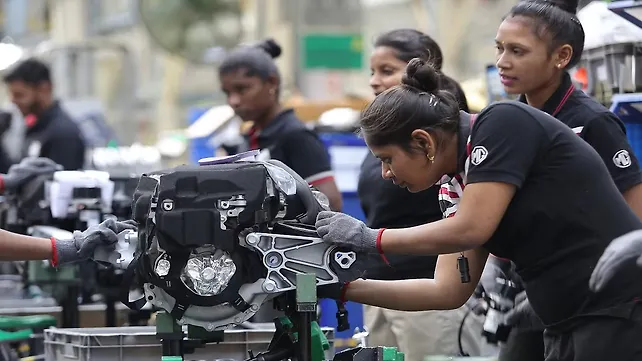
MG Motor India’s move to find a local partner for its automobile operations in Gujarat seems to have moved a step forward, going by a report published in The Economic Timeson Wednesday.
The story states that Sajjan Jindal, Chairman of the JSW Group, will buy a 45-48% stake in MG Motor with 5-8% earmarked for local dealers and employees. The Chinese parent, SAIC Motor Corp, will end up becoming a minority shareholder whose stake will be capped at 49%.
Talks have apparently kicked off between the two parties and, if things go according to plan, the business will be operated by Sajjan Jindal’s private company and not JSW Steel as widely speculated. Once an agreement is finalised, the details will become known over the next few months and then pave the way for MG Motor to enter its next phase of expansion.
What is surprising though is that the business has been valued at barely $1.5 billion which is a sixth of what was expected. For instance, companies such as Tata Motors and Mahindra & Mahindra have much higher valuations of around $9 billion for their electric vehicle businesses.
SAIC is a huge player in the automobile arena with tremendous competencies in the new energy space which makes the low valuation even more intriguing. It has also led to some speculation within industry circles about the company’s long-term plans for India and whether it will merely handhold the Jindal group till it finds its own feet.
Pragmatic Approach
“SAIC has perhaps decided to be pragmatic about the road ahead given the increasing hostilities between India and China. This explains why it is ready to offer the India business for a low price and will be content remaining a secondary partner,” says a top industry executive.
MG Motor has already indicated that the next 4-5 years will see the company being listed too by way of an IPO where SAIC’s equity component will be diluted even further. The Chinese automaker has probably figured out that it makes better sense to lend its technical expertise rather than worry constantly about political anxieties queering the business turf.
For now, Chinese entities are not permitted to make fresh investments because of the ongoing tensions between India and China. There is no indication if an end is in sight and things seem to have worsened in recent months following the Russian war on Ukraine. With China and Russia clearly in sync, India has turned to Japan, Australia and the US as part of the Quad network which effectively leaves out China.
Given this backdrop, SAIC has not been allowed to make fresh investments even while scouring for alternative funding options over the last couple of years. It was only more recently that its Indian arm, MG Motor, unveiled a new roadmap which clearly stated that the Chinese parent would take the backseat going forward.
Road Ahead
Does this mean that SAIC will eventually exit India once the Jindal group is confident enough to handle the EV business, which will be the core of operations in the future, on its own? Once its stake is diluted even further making it a marginal shareholder, the Chinese company may be content getting royalty payment from the Jindals and lend its technological expertise in new energy areas like electric and hydrogen.
“Everything is still up in the air and it is too early to predict which way the wind will blow. The Jindal group will only invest if they are assured of a strong lock-in on technology from SAIC,” says a senior auto industry official. Consequently, he adds, there is really little likelihood of the Chinese automaker exiting India which is one of the world’s top car markets.
Since the time it bought out the General Motors plant at Halol in Gujarat six years ago, MG Motor has been on overdrive revamping operations and putting its Hector SUV out on the roads in record time. This has been followed by products like Gloster and, more recently, its Comet EV.
The company has also been extra cautious in not front-facing its Chinese ownership, preferring to go with the MG Motor brand instead. Sources say SAIC learnt from its earlier India outing in 2011 — when it partnered GM as part of a revival exercise in the aftermath of the Lehman crisis — that the China brand association did not strike the right chord with customers. When it entered India the second time around, following GM’s exit, SAIC was careful to have MG Motor as its corporate brand and the move has clearly paid off.

Political Tensions
Nobody anticipated that things would go completely out of control in 2020 when COVID was on the rampage and the Chinese army decided to make things worse by occupying Indian territory along the border. This had its repercussions on business too as evident in the case of Great Wall Motors of China which was all set to enter India by buying out GM’s plant at Talegaon near Pune.
With no signs of a thaw happening between the two countries, the SUV maker decided to call it a day after nearly two years of waiting. Similarly, Changan Automobiles was also exploring the options of entering India but dropped its plans when China turned the aggressor without any provocation and at a time when India was grappling with the pandemic.
Right now, the prominent Chinese brand in India is BYD which has had its operations in Chennai for some years now. The company is keen to make a mark in the EV space with its latest offering, Atto 3, hitting all the right notes. BYD has also emerged the world’s top EV player, ahead of Tesla, and is tipped to end up as the Numero Uno in China by the end of this calendar.
SAIC, likewise, already had its operations running in India before the political slugfest broke out but it was clear that the direct investment route would no longer work given the Centre’s diktat on Chinese imports and the need for greater self-reliance. MG Motor officials indicated at the recently held Auto Expo in New Delhi that the India business was in much better shape financially with expansion plans underway at Halol.
Interim Solution
However, this was clearly an interim solution and SAIC was perhaps only too aware that there were greater challenges in growing the business with little love lost between India and China. The hunt for a local partner seems to have yielded some success with the Jindal group kicking off talks with SAIC.
Assuming that there are no glitches en route and the partners reach a win-win deal, the stage will be set for a new chapter at Halol where a second plant will come up and increase overall capacity to 300,000 units annually. There will be a new corporate brand identity for sure with the Jindal group signalling its entry into the promising EV market.
How SAIC redefines its role as a tech ally will be interesting to see given that it is keen on building its global presence in emerging markets like India and ASEAN. Political realities are taking their toll on business and the State-run Chinese automaker will factor in this reality while eyeing advanced markets like Europe for its EV foray.
The last time an Indian automaker bought out its international ally’s stake was in 2010 when M&M got into the driver’s seat for the Logan operations. This had started off as a joint venture with Renault but with the model not taking off in the market, M&M acquired Renault’s shareholding and took charge. The Logan was rechristened subsequently as Verito while Renault also began a new innings with global partner, Nissan, at Chennai.
Also Read